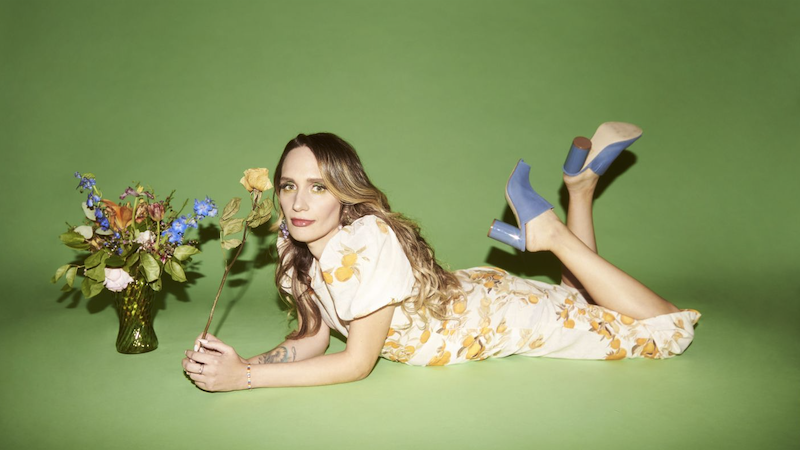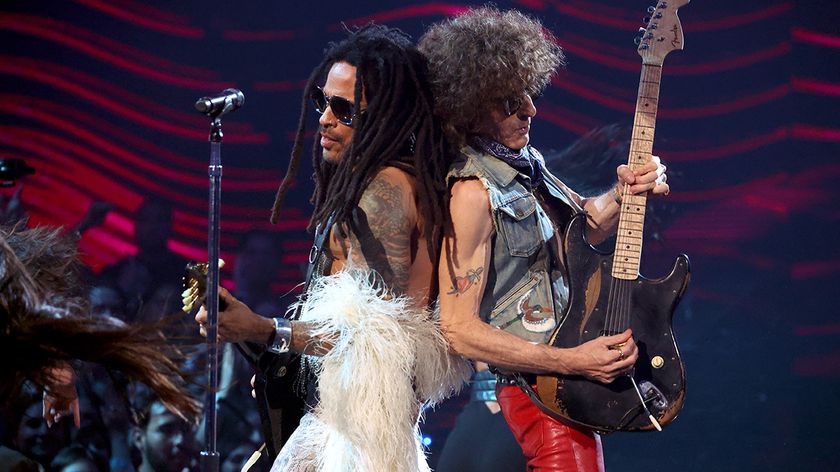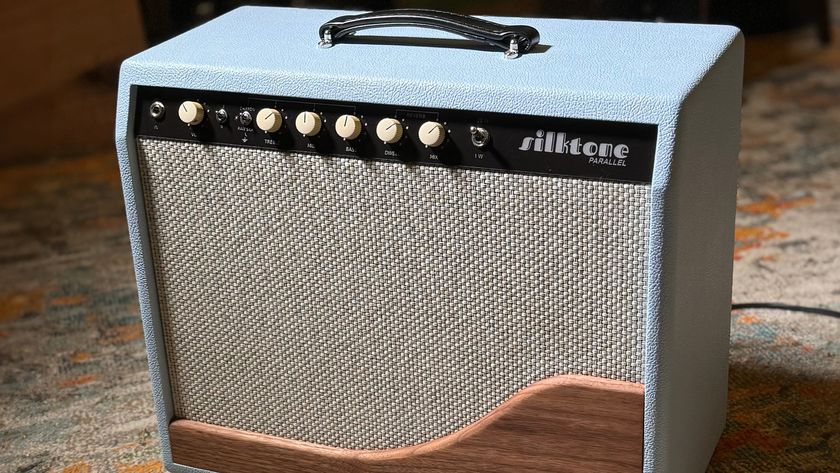Sad13: “I’ve always just come from the background of wanting to cram in as many layers in as possible”
The new solo album from Speedy Ortiz frontwoman Sadie Dupuis is an epic, dagwood-style pop-rock fever dream

In the age of ultra-hi-fi headphones and dozen-channel stereo systems that allow every for click and pop in a mix to be heard with lifelike precision, more and more artists are embracing the mindset that “less is more”. Artists like Billie Eilish, Lorde and Kevin Parker have forged entire careers out of soundscapes as bare as could be, often built up of a simple drum beat, bassline and vocal. It’s an interesting approach to music, where the ambitious and meticulous structuring of minimal elements can make a song hit just as hard as one lathered in effects, epic guitar solos and multi-layered vocal tracks that take weeks just to track.
But of course whenever one trend flourishes, so too does its antipode. For acts like 100 Gecs, Sleigh Bells and Crystal Castles, the idea that “less is more” would almost certainly result in mean-spirited scoffs. If your track’s Logic file doesn’t send the studio PC’s air vents red hot and whirring like a jet engine every time you hit ‘preview’, don’t even bother with it. Throw on at least another 17 synth tracks.
For lovers of huge, maximalist pop-rock anthems so epic and intense you’ll have your hand hovering over the replay button before your first playthrough is even finished, look no further than Haunted Painting, the poignant and polychromatic new album from Sad13 (a.k.a. Sadie Dupuis, best known as the frontwoman of Massachusetts indie-pop outfit Speedy Ortiz). It’s big and bold and incredibly beautiful, spurring heart-on-sleeve lyricisms often dark and polarisingly personal with soundscapes that feel like they’re made in tandem with coked-up Hollywood composers left to run wild in a storeroom where every instrument conceivable was free game.
And yet, somehow Haunted Painting never feels overblown or messy. It’s in fact resoundingly tight, even by the standards of Dupuis, whose work is consistently captivating and well-strung. Australian Guitar caught up with her to find out exactly how she made her magic happen.
I feel like I need to keep revisiting this album, because every time I do I pick up on some new sort of instrumental flair or get a new kind of feeling from it. Was that kaleidoscopic vibe – where every song can take a whole bunch of different forms and flavours – something you really wanted to tap into on this record?
I’m happy to hear you say that, because I feel like what I’m going for – and what I did better on this record than any of my previous ones – is just to put in a lot of these little details that you might not notice the first time around. It might take a bunch of listens to hear them, but when you do, they’re suddenly your favourite parts of the record. I know for myself, whenever I revisit something I’ve heard a lot of times before, if I notice a really small detail that I didn’t catch the dozen other times I’d heard it, that’s always the most fun thing. It’s kind of an egotistical approach, I guess, hoping that people will listen to my album enough times to catch, like, the 80th layer that only shows up for a couple seconds – but that’s exactly how I like to arrange things.
You’ve described this album as being ‘maximalist’, in rebellion to a current trend in pop music which is very focussed on minimalism and lowkey soundscapes. How did develop that concept of ‘maximalism’ as a creative theme?
I don’t know if I did the album this way so much as a rebellion to the current production trend of having things really sparse and minimalist – and I certainly respect, and even enjoy, a lot of music that is arranged that way – but I think I’ve always just come from the background of wanting to cram in as many layers in as possible. And it’s not even like I start writing a song and then progressively add more layers to them over however many months. Generally I’ll sit down for a couple of days to write and arrange things, and I kind of know what all those parts are going to be when I get there. And if I don’t know what they are, it’s very easy for me to make a note like, “Second verse, first half, needs art synth in this octave range.” I have a pretty specific palate of how I want to fill things out – even before I sit down to write or record. So it’s usually just a process of following the guidelines that my brain has already created for myself.
I’m really stunned at how you’ve nailed this balance between grungy, lo-fi guitars and bright, summery electronic parts. How did you do it?
So this is the second Sad13 record, and the first one I did, I made pretty much entirely at home. We tracked the drums later and I redid the vocals in a studio, but beyond that, I was renting a really tiny bedroom, and it was all done just directly into the computer. This time around, I went about starting to build the tracks in the exact same way – I could’ve released a second Sad13 album which was produced the same way as the first, but instead I went into studios and redid all of the soft synths; most of the guitars I did in direct, and I think some of them were just re-amped.
Get The Pick Newsletter
All the latest guitar news, interviews, lessons, reviews, deals and more, direct to your inbox!
But the unusual way that I did this record was doing a couple of songs per studio, spread out over a bunch of months – which was just by necessity. And I just wanted to make the most of all the cool equipment I was getting to use for a few days at a time. If something strange from the ‘50s had been converted into an amp, I wanted to use that for the bass, and it would sound really gnarly because I was using something that I wouldn’t get to use in any other studio. If there was some really expensive synth that I don’t have access to anywhere else in my life, I wanted that to make at least one of the tracks. It was really just being excited by the gear list of all these different studios and trying to pack in as much as possible, in a way that would let all the parts kind of play off each other.
Do you think that had much of an impact on how eclectic this record sounds?
I think so, yeah. Most of these songs come from voice memos that I’d done years ago, where I’d just sing into my phone what I thought the synth part was going to be, or a melody that could be for vocals or guitar or whatever else. And I didn’t even really sit down to write any of the songs until I was arranging them; that’s been true for a while, but I’d never started to arrange songs while looking at a studio’s gear list before this record. So I didnt even record a note of pre-production or demoing before looking at all the websites and going, “Oh, Figure 8 has a theremin – I’m going to use that! Let me make sure I write MIDI parts for that stuff.” I think just envisioning what the possibilities were for each studio I was going to be in, that kind of directed me as far as composing went.
I read the Fader article where it noted that in addition to all the guitar and keyboard parts, you played an organ, a lap steel, a marimba, a glockenspiel and an autoharp. What was it like to step out of your comfort zone with all these new instruments and playing techniques?
I mean, there was nothing I was playing that was so completely foreign to me that it was totally intimidating. I can plunk out some notes on a piano, so I can do the same thing on a marimba. The theremin was a little bit more experimental, but I used it in more of a droney way than a melodic way, which worked for the song it appeared on. But mostly, it was just really fun for me to get to incorporate all of that stuff into the album. The very first Speedy Ortiz record I did was home-recorded, and it was done while I was directing a music program for a summer camp, so I had access to all of the orchestral instruments and whatever else the camp owned for ensembles – I would just use all of that after hours. I ended up playing cello, which I can’t really play, but y’know, it was vaguely like a guitar, so I knew I could figure it out. So this was kind of a fun return to that – being like, “I vaguely know my way around stringed instruments and instruments with keys, so let me just try all of them!”
What kind of guitars were jamming out on for this record?
I got to use a bunch of cool stuff! I did some of the recording at New Monkey, which is Elliot Smith’s studio, and they have an acoustic guitar of his there that they just called ‘The Magic Guitar’. And I was kind of skeptical, because just playing in a room, it sounds like a fine, totally normal acoustic guitar. But as soon as you put a mic on it, it just has this unmistakable brightness to it. So using that was pretty fun. It was an Epiphone Texan acoustic. I got to play a Coral electric sitar, which I hadn’t used before, and that was fun to play for a little solo. I had a couple different baritone guitars. I’m not a big SG fan, but I used a couple of ones from the ‘60s and ‘70s that were really awesome, and sounded perfect for this record. I really try to get away from using stuff I own as much as possible – it’s always fun to try things out on the guitars that exist outside of my comfort zone.
Does playing live become more interesting when you have to adapt the songs to what you own?
It’s a pain in the butt to figure out how to do some stuff live [laughs]. I can sort of cheat my way through with pedals; I got a couple different synth pedals after the first Sad13 record came out, because the fretboard of a guitar is much more comfortable for me than a keyboard is. So I wound up doing a lot of the synth parts through pedals and just accepting that the sounds would be quite different. I have a bunch of different choruses, delays and overdrives that I can use to play around with, so things don’t have to sound exactly like they do on the record. It does become complicated to figure out which of those million layers I’m going to play live – I’m struggling to figure out what I’m going to play on the keyboard for the entirety of one song when there’s 15 different keyboard parts to consider.

Ellie Robinson is an Australian writer, editor and dog enthusiast with a keen ear for pop-rock and a keen tongue for actual Pop Rocks. Her bylines include music rag staples like NME, BLUNT, Mixdown and, of course, Australian Guitar (where she also serves as Editor-at-Large), but also less expected fare like TV Soap and Snowboarding Australia. Her go-to guitar is a Fender Player Tele, which, controversially, she only picked up after she'd joined the team at Australian Guitar. Before then, Ellie was a keyboardist – thankfully, the AG crew helped her see the light…

“We had 15 minutes left, and it was time to go… I just started playing that riff. Then Lenny goes, ‘Whoa, what’s that?’”: Lenny Kravitz guitarist Craig Ross reveals the serendipitous roots of a Kravitz classic

“The concept of the guitar duel at the end was just appalling”: Crossroads is an essential piece of '80s guitar lore, but not every guitar legend was a fan of the film








